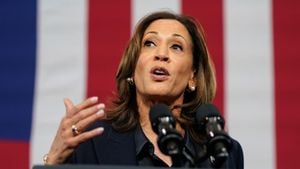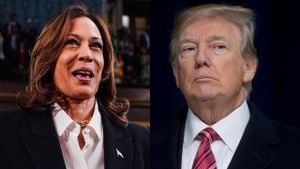Donald Trump's return to the presidency marks the beginning of what many are now dubbing his "Second Term," focused heavily on economic revitalization and stringent immigration policies. Both aspects have sparked significant discussion and debate as the nation gears up for changes expected under his leadership. This piece delves as deeply as possible, analyzing Trump's proposed economic measures and sweeping immigration reforms, which are poised to impact millions across the United States.
Throughout his campaign, Trump centered his message around fixing what he deemed the nation's "problems": rising inflation, housing prices, the healthcare system, and, of course, immigration. His promises were met with both hope and skepticism from voters, as many voters have seen firsthand the impact of previous policies.
AJC News highlighted a focal point of Trump's campaign—his pledge to conduct the largest mass deportation operation witnessed in U.S. history, drawing alarm from migrant rights advocates. The new president has continuously stated his intention to deport illegal immigrants upon taking office, putting forth troubling rhetoric about utilizing National Guard units and local law enforcement for this purpose. Such intentions have sparked concern among advocates and lawmakers alike, who worry about the logistics, legality, and potential fallout from such actions.
Experts have weighed in on the repercussions of Trump's plans. Neel Kashkari, Minneapolis Fed president, described the economic repercussions as "uncertain," particularly around the impact of mass deportations on labor sectors, such as agriculture and construction, which rely heavily on immigrant workers. Kashkari’s statements raise questions about workforce disruptions and their subsequent effect on inflation and supply chains.
During his earlier presidency, Trump enacted tariffs on imported goods, with promises to follow suit again. These tariffs are touted as tools to protect American industry; promising 10% to upwards of 60% tariffs on specific imports. Economic analysts warn, though, this could lead to rising consumer prices, negated consumer benefits from other proposed tax cuts. Trump’s ambitious plans for trade policy and immigration are being met with caution from those who argue they could backfire and escalate inflation rather than curtail it.
Another central theme of Trump's economic policy involves tax legislation. Trump has not promised new tax cuts but has suggested renewing his 2017 tax cuts, aiming to prevent a significant tax escalation set to hit the middle class soon if reforms aren’t enacted. Some of his proposals include ending taxes on tips and Social Security benefits, which would require Congressional action and face major hurdles. Meanwhile, the proposed tariffs threaten to seep through to the public, draining any potential savings from tax cuts.
The housing crisis, always a hot topic, has led Trump to propose the creation of what he calls "freedom cities" on federal land. Supporters argue this could alleviate some housing pressure, but experts remain skeptical if such projects can come to fruition swiftly enough to help those struggling with current costs. Many believe tighter immigration policies could exacerbate housing challenges by limiting labor needed for construction.
While Trump’s economic policies remain ambiguous, his stance on immigration is decidedly clear: aggressively tighten borders and pressure other nations to halt immigration flows through economic means. This includes imposing tariffs on countries like Mexico until they comply with U.S. demands related to migration. Such policies not only invite scrutiny from neighboring countries but also at home where farms and businesses could swell under labor shortages.
Trump’s immigration policies extend beyond just deportations and tariffs. He has hinted at ending programs like the Biden administration's CBP One app, which facilitates asylum applications. This raises significant concerns among migrants who fear their pathways to legal entry may be severely hampered, leaving those with desperate circumstances with even fewer options.
But shifts won't just affect immigrants; they will likely reverberate throughout the economies of states like California, with over 10 million immigrants. This demographic's economic contributions, which remarkably amount to approximately $8.5 billion annually, could see significant shifts as Trump moves to enforce stricter laws. California Governor Gavin Newsom has already voiced concerns, stating, "If Donald Trump is successful with deportations, no state will be more impacted from a fiscal perspective, from an economic perspective." Immigration reform, he fears, could destabilize communities.
Similarly, challenges abound as lawmakers are already planning to organize legal defenses to counter Trump’s anticipated moves. Preparations for lawsuits and challenges to impending measures against immigrants are underway, highlighting the fierce opposition and anxiety felt by advocates and citizens alike who worry about the ramifications of Trump's policies.
With dreams of economic revival, Trump's administration is betting on controlling immigration and tariffs as central pillars for stimulating growth. Yet, with so many effects interconnected, his promises to fix the economy and secure the border leave many questions unanswered. Whether Trump’s strategies will revitalize the economy or sow discord and division remains to be seen.
Trump's economic track record suggests difficulty. Many critics remain unconvinced he will achieve the alleged prosperity he envisions without negative consequences. Unlike earlier predictions of gloom and doom, the concern now resonates around heightened inflation and the welfare of American workers. A complicated dance of policies could greatly shape the economic and social landscapes of the country over the next four years.
Pressures will mount as the administration must navigate between fulfilling ambitious election promises and rectifying economic strife—both domestically and internationally. The resilience of communities and economies across the U.S. will face trials unlike any seen before as outcomes stemming from the Trump policy turns take shape.



